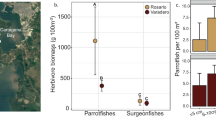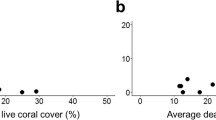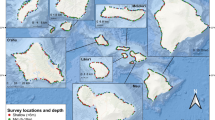Abstract
The hypothesis that herbivory is higher in areas without fishing and will increase the rate at which hard coral communities return to pre-disturbance conditions was tested in and out of the marine protected areas (MPA) of Kenya after the 1998 El Niño Southern Oscillation (ENSO). Herbivory was estimated by assay and biomass methods, and both methods indicated higher herbivory in fishery closures. Despite higher herbivory, the effect of the ENSO disturbance was larger within these closures, with reefs undergoing a temporary transition from dominance by hard and soft coral to a temporary dominance of turf and erect algae that ended in the dominance of calcifying algae, massive Porites, Pocillopora and a few faviids six years after the disturbance. The fished reefs changed the least but had a greater cover of turf and erect algae and sponge shortly after the disturbance. Higher herbivory in the fishery closures reduced the abundance and persistence of herbivore-susceptible erect algae and created space and appropriate substratum for recruiting corals. Nonetheless, other post-settlement processes may have had strong influences such that annual rates of coral recovery were low (∼2%) and not different between the management regimes. Recovery, as defined as and measured by the return to pre-disturbance coral cover and the dominant taxa, was slower in fishery closures than unmanaged reefs.



Similar content being viewed by others
References
Bellwood DR, Hughes TP, Folke C, Nystrom M (2004) Confronting the coral reef crisis. Nature 429:827–833
Carreiro-Silva M, McClanahan TR (2001) Echinoid bioerosion and herbivory on Kenyan coral reefs: the role of protection from fishing. J Exp Mar Biol Ecol 262:133–153
Cole J, Dunbar R, McClanahan T, Muthiga N (2000) Tropical Pacific forcing of decadal variability in SST in the western Indian Ocean. Science 287:617–619
Field A (2005) Discovering statistics using SPSS, 2nd edn. Sage, London, p 779
Fox HE (2005) Rapid coral growth on reef rehabilitation treatments in Komodo National Park, Indonesia. Coral Reefs 24:263
Goreau T, McClanahan T, Hayes R, Strong A (2000) Conservation of coral reefs after the 1998 global bleaching event. Conserv Biol 14:5–15
Harrington L, Fabricius FH, De’ath G, Negri A (2004) Recognition and selection of settlement substrata determines post-settlement survival in corals. Ecology 85:3428–3437
Hay ME (1991) Fish–seaweed interactions on coral reefs: effects of herbivorous fishes and adaptations of their prey. In: Sale PF (ed) The ecology of coral reef fishes. Academic, New York, pp 96–119
Hill MO, Gauch HGJ (1980) Detrended correspondence analysis, an improved ordination technique. Vegetation 42:47–58
Hoegh-Guldberg O (1999) Climate change, coral bleaching and the future of the world’s coral reefs. Mar Freshw Res 50:839–866
Holling CS (2001) Understanding the complexity of economic, ecological, and social systems. Ecosystems 4:390–405
Hughes TP, Baird AH, Bellwood DR, Card M, Connolly SR, Folke C, Grosberg R, Hoegh-Guldberg O, Jackson JBC, Kleypas J, Lough JM, Marshall P, Nystrom M, Palumbi S, Pandolfi JM, Rosen B, Rougharden J (2003) Climate change, human impacts, and the resilience of coral reefs. Science 301:929–933
Hughes TP et al. (2007) Phase shifts, herbivory, and resilience of coral reefs to climate change. Curr Biol 17(4):360–365
Ives AR, Carpenter SR (2007) Stability and diversity of ecosystems. Science 317:58–62
Jones GP, McCormick MI, Srinivasan M, Eagle JV (2004) Coral decline threatens fish biodiversity in marine reserves. Proc Natl Acad Sci USA 101:8251–8258
King AW, Pimm SI (1983) Complexity, diversity, and stability: a reconciliation of theoretical and empirical results. Am Nat 122:229–239
Lewis SA (1986) The role of herbivorous fishes in the organization of a Caribbean reef community. Ecol Monogr 56:183–200
Littler MM, Littler DS (1980) The evolution of thallus form and survival strategies in benthic marine macroalgae: field and laboratory tests of a functional form model. Am Nat 116:25–44
McClanahan TR (1992) Resource utilization, competition and predation: a model and example from coral reef grazers. Ecol Modell 61:195–215
McClanahan TR (2002) The near future of coral reefs. Environ Conserv 29:460–483
McClanahan TR, Shafir SH (1990) Causes and consequences of sea urchin abundance and diversity in Kenyan coral reef lagoons. Oecologia 83:362–370
McClanahan TR, Kaunda-Arara B (1996) Fishery recovery in a coral-reef marine park and its effect on the adjacent fishery. Conserv Biol 10:1187–1199
McClanahan TR, Obura DO (1996) Coral reefs and nearshore fisheries. In: McClanahan TR, Young TP (eds) East African ecosystems and their conservation. Oxford University Press, New York, pp 67–99
McClanahan TR, Maina J (2003) Response of coral assemblages to the interaction between natural temperature variation and rare warm-water events. Ecosystems 6:551–563
McClanahan TR, Nugues M, Mwachireya S (1994) Fish and sea urchin herbivory and competition in Kenyan coral reef lagoons: the role of reef management. J Exp Mar Biol Ecol 184:237–254
McClanahan TR, Muthiga NA, Mangi S (2001) Coral and algal response to the 1998 coral bleaching and mortality: interaction with reef management and herbivores on Kenyan reefs. Coral Reefs 19:380–391
McClanahan TR, McLaughlin SM, Davy JE, Wilson WH, Peters EC, Price KL, Maina J (2004) Observations of a new source of coral mortality along the Kenyan coast. Hydrobiologia 530/531:469–479
McClanahan TR, Maina J, Starger CJ, Herron-Perez P, Dusek E (2005) Detriments to post-bleaching recovery of corals. Coral Reefs 24:230–246
McClanahan TR, Verheij E, Maina J (2006) Comparing management effectiveness of a marine park and a multiple-use collaborative fisheries management area in East Africa. Aquat Conserv 16:147–165
McClanahan TR, Ateweberhan M, Muhando C, Maina J, Mohammed SM (2007a) Effects of climate and seawater temperature variation on coral bleaching and mortality. Ecol Monogr 77(4) (in press)
McClanahan TR et al. (2007b) Western Indian Ocean coral communities, bleaching responses, and susceptibility to extinction. Mar Ecol Prog Ser 337:1–13
Morse ANC, Iwao K, Baba M, Shimoike K, Hayashibara T, Omori M (1996) An ancient chemosensory mechanism brings new life to coral reefs. Biol Bull 191:149–154
Mumby PJ, Dahlgren CP, Harborne AR, Kappel CV, Micheli F, Brumbaugh DR, Holmes KE, Mendes J, Broad K, Sanchirico JN, Buch K, Box S, Stoffle RW, Gill AB (2006) Fishing, trophic cascades, and the process of grazing on coral reefs. Science 311:98–101
Saji NH, Goswami BN, Vinayachandran PN,Yamagata (1999) A dipole mode in the tropical Indian Ocean. Nature 401:360–363
Sall J, Lehmaan A, Creighton L (2001) JMP start statistics, 2nd edn. Thomson Learning/Duxbury, Belmont, CA
Sheppard CRC (2003) Predicted recurrences of mass coral mortality in the Indian Ocean. Nature 425:294–297
Soong K, Chen T (2003) Coral transplantation: regeneration and growth of Acropora fragments in a nursery. Rest Ecol 11:62–71
Steneck RS (1986) The ecology of coraline algal crusts: convergent patterns and adaptive strategies. Annu Rev Ecol Syst 17:273–303
Tamelander J (2002) Coral recruitment following a mass mortality event. Ambio 31:551–557
West JM, Salm RV (2003) Resistance and resilience to coral bleaching: implications for coral reef conservation and management. Conserv Biol 17:956–967
Williams ID, Polunin VC, Hendrick VJ (2001) Limits to grazing by herbivorous fishes and the impact of low coral cover on macroalgal abundance on a coral reef in Belize. Mar Ecol Prog Ser 222:187–196
Acknowledgments
I thank H. Machano Ali, R. Arthur, A. Kamukuru, B. Kaunda-Arara, R. Kiambo, J. Maina, S. Mangi, J. Mariara, N. Muthiga, S. Mwachireya, H. Peters, and M. J. Rodriques for assistance with the fieldwork and E. Darling and J. Omukoto for help with the statistics, graphs, and tables. The Wildlife Conservation Society funded the research and the Kenya Wildlife Service granted permission to work in the parks and provided logistic support. Kenya’s Ministry of Science and Technology provided research clearance.
Author information
Authors and Affiliations
Corresponding author
Additional information
Communicated by Katrin Rudmann.
Rights and permissions
About this article
Cite this article
McClanahan, T.R. Response of the coral reef benthos and herbivory to fishery closure management and the 1998 ENSO disturbance. Oecologia 155, 169–177 (2008). https://doi.org/10.1007/s00442-007-0890-0
Received:
Accepted:
Published:
Issue Date:
DOI: https://doi.org/10.1007/s00442-007-0890-0




